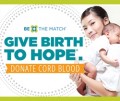You are here
News
2014
Dec 2014 Nina and Zach Miller were the first parents from the United States to take their daughter Josephine, who has cerebral palsy, to South Korea for therapy with donated cord blood. The Millers participated in a registered cliical trial at the CHA Bundang Medical Center.
Dec 2014 Graft-versus-Host Disease (GvHD) is a common and serious complication following a stem cell transplant from an unrelated donor. GvHD is divided into acute and chronic form according to the clinical course and time of the diagnosis. It is a life-threatening condition, which contributes greatly to early mortality after stem cell transplants. Survivors may suffer organ damage and have impaired quality of life.
Nov 2014 Thalassemias are blood disorders passed down through families (inherited) in which the body makes an abnormal form of hemoglobin. Hemoglobin is the protein in red blood cells that carries oxygen. Thalassemia disorders result in large numbers of red blood cells being destroyed, which leads to anemia.
Nov 2014 Very early in the field of cord blood banking, laboratories that process cord blood for storage began removing most of the plasma (plasma depletion) and the red blood cells (RBC depletion) before cryopreserving the remaining component of the blood that holds the stem cells.
Oct 2014 A suitable cord blood match (HLA match of 4 out of 6 or better) is available from Be The Match for nearly every US patient under age 20 and for more than 80% of patients age 20 and over, regardless of racial or ethnic background. The challenge at this point is how best to apply the limited resources of the Be The Match organization to find matches for the remaining patients, who are predominantly ethnic minorities and mixed race individuals.
Oct 2014 Canada has the most ethnically diverse population in all of the Group of Eight (G-8) leading industrialised countries (1). Over 20% of Canada's population is foreign-born, with representation from almost 200 countries. Among those who arrived since 2001, almost 60% are from Asia (including the Middle East). Currently, 20% of the population identify themselves as members of a visible minority, which accounts for over 6 million people. The median age of this group, 33.4 years, is within the child-bearing years.
Sep 2014 Massachusetts General Hospital (MGH) investigators have made an important step towards greater availability of hand transplants, face transplants and other transplants involving multiple types of tissue, and stem cells play an important role. Hand, face and soft tissue transplants are collectively known as vascularized composite allografts, or VCAs. A VCA transplant is one that involves transplantation of multiple tissue types: muscle, bone, nerves and skin. They are most frequently used to replace amputated hands and arms, and to repair severe facial injuries.
Sep 2014 Adriana was born in Italy in 2009 after an in vitro fertilization and her parents were finally achieving the dream of their lives. Everything appeared to be fine with the pregnancy until the last moment when the mother started to feel contractions and ran to the clinic. She had forgotten to bring the kit for storing cord blood stem cells, but luckily Francesco from SmartBank reached them at the clinic right on time.
Sep 2014 Cord blood banking can preserve viable stem cells for decades if the cryogenic nitrogen tanks are maintained at a constant very low temperature.
Aug 2014 Americord Registry, a leading cord blood banking company based in New York City, has made major strides in addressing one of the major limitations of cord blood banking: the relatively low volume of stem cells that are typically collected from cord blood. A typical cord blood collection generally harvests enough stem cells to treat a patient who weighs up to 65 pounds. This volume of stem cells may be used to treat a patient over 65 pounds as a last resort, but these transplants have a much lower success rate than transplants containing an appropriate number of stem cells.










